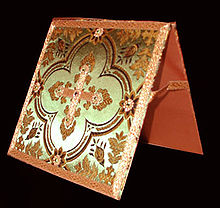Bursa (liturgy)
A bursa or burse is a parament in the shape of a small bag that is used in the liturgy of the Catholic and Evangelical Lutheran Churches. The corporal is kept in it.
The bursa has the same liturgical color and occasionally the same ornamentation as the chasuble . A cross can be embroidered on the top. The two halves of the bursa are sewn together on one side and tied with ribbons or gussets on two sides to prevent the corporal from falling out. Until the liturgical reform of the Second Vatican Council, the bursa was carried by the priest on the chalice to the altar when entering Holy Mass and placed there upright.
Since the corporal came into contact with the Holy of Holies , great care was taken with its storage. In the Middle Ages, in addition to the bursa ( pera , bursa ), flat boxes ( capsa , capsella , cassus , domus corporalium , in German korporalienhus ) were used, which were the size of a folded corporal and covered with velvet or silk and with embroidery or pearls could be decorated.
This explains the suitable for hanging Bursa, in which the developed priests , the Holy Communion and the oil for the anointing of the sick brings to a patient, known Versehburse. It should be white.
A so-called Bursen reliquary is a container in which a relic is kept. This form of bursa also developed from the bursa used in the liturgy .
literature
- Joseph Braun : The Liturgical Paraments in the Present and Past. Reprographic reprint of the second, improved edition, publisher nova & vetera, Bonn 2005, ISBN 3-936741-07-7 , pp. 215-217 (1st edition: 1911, 2nd edition: 1924).
See also
Individual evidence
- ↑ Joseph Braun: The Liturgical Paraments in the present and past. Reprographic reprint of the second, improved edition (1924), Bonn 2005, pp. 215f.
